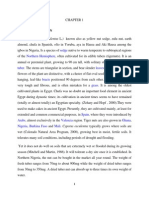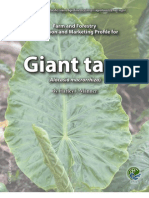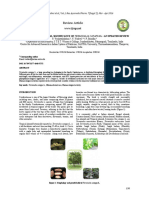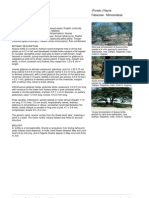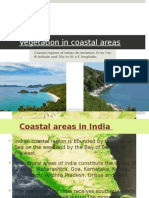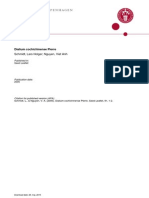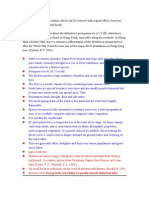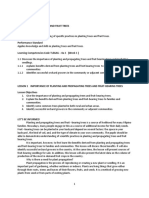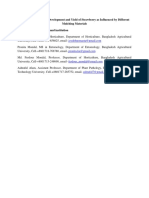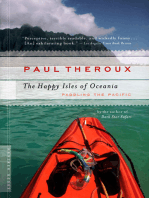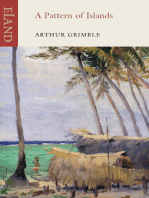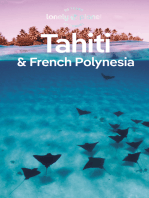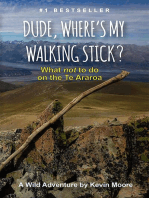Professional Documents
Culture Documents
Almond 1
Uploaded by
Mahantesh PanchalOriginal Description:
Copyright
Available Formats
Share this document
Did you find this document useful?
Is this content inappropriate?
Report this DocumentCopyright:
Available Formats
Almond 1
Uploaded by
Mahantesh PanchalCopyright:
Available Formats
Terminalia catappa (tropical almond)
Combretaceae (combretum family)
alite (Solomon Islands pidgin); autaraa, aua, auarii, auariiroa (Societies); kamani haole, kamani ula, false kamani
(Hawaii); kauariki, kaukauariki, taraire (Cooks: Mangaia); maii, koaii, kouaii, taie (Marquesas); natapoa (Vanu-
atu: Bislama); tropical, beach, or Indian almond (English); talie (Samoa); talise (Papua New Guinea: Tok Pisin);
tavola, tivi (Fiji); telie (Tonga, Uvea, Futuna, Tokelau, Tuvalu)
Lex A. J. Tomson and Barry Evans
IN BRIEF
Distribution Naturally widespread in sub
tropicalandtropicalzonesofIndianandPacifc
Oceans and planted extensively throughout the
tropics.
Size Largetree2540m(82130ft)tall.
Habitat Subtropical and tropical maritime
climates with annual rainfall generally 1000
3500mm(40140in);elevationsbelow300400
m(10001300ft).
Vegetation Associated with coastal vegetation,
especially strandline communities and beach
forestsincludingrockyshoresandedgesofman
groveswamps.
Soils Adapted to a wide range of lighter tex
turedsoiltypes.
Growth rate Fast in early years, about 2 m/yr
(6.6ft/yr).
Mainagroforestryuses Soilstabilization,coas
talprotection.
Mainproducts Nuts,timber.
Yields Kernelyieldisestimatedtobeabout5kg
(11lb)pertreeperyear;timberyieldscanreach
1520m
3
/ha/yr(215286ft
3
/ac/yr)(estimate).
Intercropping Short term crops can be
interplanted during the frst 23 years after es
tablishment.
Invasive potential Has moderate potential for
invasivenessintodisturbedseasidehabitats.
SpeciesProflesforPacifcIslandAgroforestry
www.traditionaltree.org
April2006
ver.2.2
p
h
o
t
o
:
C
.
E
l
E
v
i
t
C
h
Large tree near shoreline, Apia, Samoa.
2 Terminalia catappa(tropicalalmond)
INTRODUCTION
Tropicalalmond (Terminalia catappa)isalarge,spreading
treenowdistributedthroughoutthetropicsincoastalen
vironments.Tetreeistolerantofstrongwinds,saltspray,
and moderately high salinity in the root zone. It grows
principallyinfreelydrained,wellaerated,sandysoils.
Tespecieshastraditionallybeenveryimportantforcoastal
communities, providing a wide range of nonwood prod
ucts and services. It has a spreading, fbrous root system
andplaysavitalroleincoastlinestabilization.Itiswidely
plantedthroughoutthetropics,especiallyalongsandysea
shores, for shade, ornamental purposes, and edible nuts.
Tetimbermakesausefulanddecorativegeneralpurpose
hardwoodandiswellsuitedforconversionintofurniture
and interior building timbers. Fruits are produced from
about3yearsofage,andthenutritious,tastyseedkernels
maybeeatenimmediatelyafterextraction.
Tropicalalmondiseasilypropagatedfromseed,andisfast
growingandfourisheswithminimalmaintenanceinsuit
ableenvironments.Selectedcultivarsofthespecieswarrant
widercommercialplantingforjointproductionoftimber
and nuts.Te tree has a demonstrated potential to natu
ralize in coastal plant communities, but not to adversely
dominatesuchcommunities.
Teproductivityandmarketingofcultivarswithlargeand/
or softshelled nuts needs to be assessed.Tere is also a
need for experimental work to develop vegetative propa
gation techniques and more efcient techniques for pro
cessing fully mature fruits including drying, storage, and
crackingofnuts.
DISTRIBUTION
Nativerange
Tropical almond has a vast natural distribution in near
coastal areas of the Indian Ocean, through tropical Asia,
andintothePacifcOcean.Teextenttowhichitsrange
has been increased through movement and dispersal by
humansisdifculttodetermine.ItextendsfromtheSey
chellesthroughIndia,theAndamansandadjacentislands,
and throughout Southeast Asia (Myanmar,Tailand, the
MalayPeninsula,Vietnam,thePhilippines,Indonesia)to
Papua New Guinea and northern Australia as far south
astheTropicofCapricorn.Tespeciesisfoundthrough
out the South Pacifc region, including the Solomon Is
lands,Vanuatu,andFiji.Itispresentonnearlyallthehigh
archipelagos of Polynesia and Micronesia but may be an
aboriginal introduction to the eastern parts of its current
range(includingallofeasternPolynesia).
Currentdistribution
Tropicalalmondhasbeenintroduced,andfrequentlynatu
ralized,inmanytropicalpartsoftheworldincludingBrazil,
theCaribbean,andEastAfrica.ItisnaturalizedinFlorida
and Puerto Rico. In Hawaii, the species was introduced
veryearly,probablybefore1800,andisnownaturalizedat
lowaltitudes,mainlynearbeachshores.
BOTANICAL DESCRIPTION
Preferredscientifcname
Terminalia catappa L.
Family
Combretaceae(combretumfamily)
Non-preferredscientifcnames
PhytolaccajavanicaOsbeck
TerminaliamauritianaBlanco
TerminaliamoluccanaLamk.
TerminaliaproceraRoxb.
Commonnames
alite(SolomonIslandspidgin)
autaraa,aua,auarii,auariiroa(Societies)
kamani haole,kamani ula,falsekamani(Hawaii)
kauariki,kaukauariki,taraire(Cooks:Mangaia)
maii,koaii,kouaii,taie(Marquesas)
natapoa(Vanuatu:Bislama)
tropical,beach,orIndianalmond(English)
talie(Samoa)
talise(PapuaNewGuinea:TokPisin)
tavola,tivi(Fiji)
telie(Tonga,Uvea,Futuna,Tokelau,Tuvalu)
Size
Tropical almond is a medium to large tree to 2540 m
(82130 ft) in height and with a similar crown spread in
opensituations.Atmaturitythetrunkattainsadiameter
atbreastheight(dbh)of50150cm(2060in).
Typicalform
Youngertreesdisplayacharacteristicpagodaform,witha
singleboleandmonopodialhorizontalbranchinginregu
lar false whorls of 45 branches. Along each lateral, new
branchesareformedinacharacteristic,bifurcatingpattern.
Tetieredcrownbecomesfatterwithwidespreadbranches
inolderspecimens.Teboleisusuallystraightandreason
ablycylindrical,butinexposedcoastalsituationsitmaybe
SpeciesProhlesforPacihcIslandAgroforestry(www.traditionaltree.org) 3
crooked and/or leaning. Buttresses, when present, are up
to3m(10ft)inheight,variable,straighttocurved,thick
tothin,sometimesbranching.Largetreesmaydevelopbig,
occasionally branching buttresses and often have twisted,
leaningtrunks.
Flowers
Tefowersaresmall(46mm[0.160.24in]across),white
or creamcolored, fvelobed, arranged on long (825 cm
(3.210 in) axillary spikes, with a mildly unpleasant smell.
Withinaspikethemajorityofthefowersaremale,with
only a few bisexual fowers positioned toward the base.
Plants usually commence fowering and fruiting from a
young age, e.g., within 23 years of outplanting, but this
varieswithsiteandgenotype.Onhighlyfertilesitesmature
fruitshavebeencollectedfrom18montholdplants.Trees
may refoliate and fower very soon (e.g., within 6 weeks)
afterbeingcompletelydefoliatedbycyclonicwinds.
InHawaii,Fiji,Vanuatu,andTongafoweringandfruiting
occursporadicallythroughoutmuchoftheyear.Flowering
and fruiting of cultivated trees appears to be more syn
chronous in Vanuatu, where fowering peaks around Oc
tobertoJanuaryandisfollowedbyfruitingaroundMarch
toJune.
Leaves
Teleavesarearrangedinclosespirals,oftencrowdedto
wardtheendsoftheupturnedbranchlets.Teleafbladeis
simple, broadly obovate, 825(38) x 514(19) cm (310[
15]x26[7]in),with(5)812pairsofsecondaryveins.Te
leaftipisroundedandblunt,graduallytaperingtoanar
rowly subcordate base (the latter being a useful diagnos
ticfeature).Newleaveshaveacoveringofsoft,appressed,
brown hairs. Mature leaves are mostly glabrous (shiny),
leathery,anddarkgreen,turningbrightyellowthenvivid
to dark red before falling.Te trees are briefy deciduous
Top left: Close-up of fowers and buds. photo: l. thomson Right: Fruits on tree. photo: C. ElEvitCh Bottom left: Horizontal
branchingofyoungtrees.photo:C.ElEvitCh
4 Terminalia catappa(tropicalalmond)
duringthedryseason,orinsomeenvironmentstheymay
losetheirleavestwiceinayear.
Fruit
Typically one to fve fruits develop on the basal part of
thefowerspike.Tefruitisasessile,laterallycompressed,
ovoidtoovate,smoothskinneddrupe.Duringmaturation,
itchangescolorfromgreenthroughyellowtobrightred
ordarkpurplishredatfullmaturity.Fruitsizevariescon
siderably,e.g.,3.57x25.5cm(1.42.8x0.82.2in),with
extremesinlengthfrom2.5to10cm(14in).Tekernel
consists of two delicate and intricately entwined cotyle
dons enclosed in an inconspicuous creamcolored, rarely
red,testa.
In the South Pacifc tropical almond growing at lower
latitudes may produce fruit sporadically throughout the
year,withheaviercropstowardtheendoftheyearontrees
growingathigherlatitudes.InNewGuineatheproductive
period is between November and March, especially De
cemberFebruary.InVanuatuthemaincropisaroundthe
middleoftheyear(MayJune),withasmallercroparound
December.InSamoafruitingoccursinJuneJulyandFeb
ruaryMarch.InTongathereportedfruitingseasonvaries
betweenislandgroups,e.g.,SeptemberDecemberinthe
south (Tongatapu and Eua) and FebruaryMay further
north(HaapaiandVavau).
Seeds
In the Pacifc islands trees exhibit large variations in the
size and shape of fruits, nuts, and kernels, but it is dif
culttoclassifythisvariation.Forexample,inVanuatu,the
nutscanbe3.95.1longby2.63.8cmacross(1.52x11.5
in)andweigh714g(0.250.5oz).Kernelsareinthesize
rangeof2.24.4x81.4cm(0.91.7x0.30.6in)andweigh
0.10.9 g (0.040.32 oz). Te percentage kernel content
variesfrom1%to10%.
Te rind of the fruit is a light, pithy, or corky tissue that
enablesthefruittofoatandbedispersedbyseacurrents.
Treesarealsofoundawayfromcoastsduetofruitsbeing
carriedinlandanddroppedbyfrugivorousbirdsandbats,
andasaresultofdeliberateplantingbyhumans.
Bark
Tebarkisgraytodarkgraybrownandshallowlyfssured.
Continuous vertical fssuring and discontinuous horizon
talcracksproduceagridappearance;thesomewhatfaky
barkpeelsofincurvedorstraightscalesalongtheselines.
Rootinghabit
Te trees usually have a spreading, fbrous, nearsurface
Top:Buttressoflargetree,Hilo,Hawaii.photo:J.B.Friday
Bottom:Teextensivesurfacerootsystemisexposedonthis
sandy,coastalslope.photo:C.ElEvitCh
SpeciesProhlesforPacihcIslandAgroforestry(www.traditionaltree.org) 5
lateralrootsystem,althoughthespeciesisnor
mallydeeprootedinsand(Francis1989).Shal
lowlateralrootsystemscandevelopinresponse
tohighwatertables,makingsuchtreessuscep
tibletowindthrow(Wood1970).
Similarorlook-a-likespecies
Te genus Terminalia comprises about 150250
tropical tree species. Closely related species in
the South Pacifc include T. glabrata Forst. f.
andT. littoralisSeem.
Howtodistinguishfromsimilar
species/look-a-likes
Tropical almond is distinguished from most
Terminaliaspp.byitssubcordate(heartshaped)
leafbase.T. catappahaslarger,glossy,darkgreen
leaves, thicker branchlets, longer fower spikes,
andlargerfruitsthanT. littoralis(typically>3.5
5cm[>1.42in]comparedwith2.5cm[1in]
long).T. catappaisdistinguishedfromtheeast
ernPolynesianT. glabratabyitsshorter,thicker
leafpetiolestypically1.5cm(0.6in)compared
with 1.52.5 cm (0.61in) long; heartshaped
leafbasecomparedwithcuneatetoacute;and
winged,typicallylargerfruits>3.55cm(>1.42
in) compared with 2.55 cm (12 in) long and
morestronglyangledfruits.Someauthorscon
siderT. glabratatobeawildformofT. catappa,
and more taxonomic studies, including using
molecular markers, may be needed to deter
minetheclassifcationstatusofT. glabrata.
GENETICS
Variabilityofspecies
Major variation exists in a range of economi
callyimportantnutcharacteristics,mainlyasa
resultoftraditionalselectionfortreeswithde
sirable traits and their propagation by peoples
in various parts of its range in Melanesia. Selection has
occurredforlargefruitsand/orkernelsandeaseofcrack
ing.InVanuatuthevariabilityinthespeciesishigh;varia
tions occur mainly in fruit size, color, and shape (Walter
andSam1993).Tereislittlevariationwithinthespecies
inmostpartsoftheSolomonIslands,exceptfortheSanta
Cruz Islands (Temotu Province) where selection has pro
ducedsomelargefruitedforms.Twofruittypeshavebeen
reportedfromtheMussauIslands,BismarckArchipelago,
PapuaNewGuinea(Lepofsky1992).Onetypehasasoft
endocarp that can easily be broken with the teeth, while
the other has a hard endocarp that must be hit with a
stoneorcutwithaknifetoextractthenut;itisuncertain
whether the softshelled trees breed true to type.Te is
landofIwa,intheMarshallBennettGroup(PNG),isalso
renownedforitssoftshellednuts.InTongatwoformsare
distinguished:thosewithredfruits(telie kula)foundalong
beachesandthosewithlightgreenfruits(telie hina)found
inland.InaRapidRuralAppraisalstudy,fourfolkloreva
rietieswereidentifedforHaapai(Tonga),i.e.,amanu,lau
lalahi,lalike,andkai(TupoulahiFusimalohi1999).InSa
Top: Comparison of fowering twigs of T. littoralis (left) and T. catappa
(right). photo: l. thomson Bottom: T. littoralis, Upolu, Samoa. photo: C.
ElEvitCh
6 Terminalia catappa(tropicalalmond)
moathereismodernintroductionofT. catappawithlarger
ediblefruits.
In India several forms difering in leaf shape and fruit
characteristicshavebeenrecognized.Onetypehasaned
ible, sweet fesh (mesocarp) and is cultivated in gardens.
Variation has also been reported in kernel taste and size
from planted trees in the Caribbean and the southern
UnitedStates.
Knownvarieties
Whilemanyvariantsarereported(seeabove),thespecies
is invariably propagated from seed, which gives rise to
variationintheofspring.Accordinglythereiscontinuous
variationwithintermediateformsforvariouscharacters.
Te species should be highly amenable to improvement
throughabreedingprogramgiven
thehighlevelofvariationinnutcharacteristics
short intergeneration times, i.e., the young age, about
34years,atwhichplantsfowerandfruit,and
ready access to fowers in low lateral branches for con
trolled pollination (although the fowers are small and
crowded).
ASSOCIATED PLANT SPECIES
Tropicalalmondisacharacteristicspeciesoftropicalbeach
forests,especiallyraisedsandybeachesabovehightide.It
is also found along rocky shores, and sometimes on the
edgesofmangroveswamps.Itmayalsogrowasapioneer
on denuded or disturbed lands up to 300 m (1000 ft) el
evation.InVanuatuoccasionalseeminglywildtreesinthe
forest are likely to be remnants of former settlements or
gardens.InFrenchPolynesia,itappearstohavepartlyre
placedtheindigenousT. glabrata.
Associatedspeciescommonlyfoundinnative
habitats
Associatedspeciesinclude Acacia simplex,beachheliotrope
(Tournefortia argentea), Barringtonia asiatica, Calophyllum
inophyllum, beach sheoak (Casuarina equisetifolia), coco
nut(Cocos nucifera),Cordia subcordata,Excoecaria agallocha,
Hernandia nymphaeifolia,beachhibiscus(Hibiscus tiliaceus),
Intsia bijuga, noni (Morinda citrifolia), Scaevola tacca-
da, Schleinitzia insularum, Terminalia littoralis, Tespesia
populnea,andVitex trifoliata.
ENVIRONMENTAL PREFERENCES
AND TOLERANCES
Climate
Tropical almond is well adapted to maritime subtropical
andtropicalclimateswhererainfallisusuallyintherange
of10003500mm(40140in)perannum,distributedrath
eruniformlythroughouttheyearorwithasummermaxi
mum.Itisinvariablyfoundnearthecoast,atelevationsof
less than 300400 m (10001300 ft), where there is little
seasonalanddiurnalvariationintemperatures.Teentire
rangeisfrostfree.
Ilevationrange
1400m(31310ft).
Meanannualrainfall
10003500(4500)mm(40140[180]in).
Rainfallpattern
Tetreeprefersclimateswithsummeroruniformrainfall
patterns.
ryseasonduration(consecutivemonthswith<40
TERMINALIA TERMS
Fruittheouterskin(exocarp)andfesh(mesocarp),
theshell(endocarp),andkernel.
Nuttheshell(endocarp)andthekernel.
Kernelthe edible kernel or seed and testa (skin
surroundingtesta).
Kernels from three selected nut morphotypes of tropical
almond (left) compared with wild type (right) in Vanuatu.
photo:K.aKEn
SpeciesProhlesforPacihcIslandAgroforestry(www.traditionaltree.org) 7
mm|1.6in|rainfall)
Upto46months.
Meanannualtemperature
2328C(7382F)
Meanmaximumtemperatureofhottestmonth
2532C(7790F)
Meanminimumtemperatureofcoldestmonth
1724C(6375F)
Minimumtemperaturetolerated
57C(4145F)(estimated)
Soils
Tropical almond naturally occurs on various coastal soils,
especiallyraisedsandyandrockybeaches.Itisadaptedtoa
widerangeoflightertexturedsoiltypes,includingbrack
ish/saline and alkaline sands over limestone, but requires
gooddrainagewhengrownonheavier,clayeysoils.
Soiltexture
Itpreferslighttomediumsoils(sands,sandyloams,loams,
andsandyclayloams).
Soildrainage
Itrequiresfreelydrainingsoils.
Soilacidity
Acidtoneutral/mildlyalkalinesoils(pH4.08.5).
Specialsoiltolerances
Tropicalalmondtoleratesshallowsoilsandslightlysaline
soils.
Tolerances
rought
It is likely to be tolerant of droughts of less than 46
monthsdurationandmayshedleaves/canopytowithstand
longdryspells.
Iullsun
Te tree grows most rapidly in full sun and regenerates
mainlyinopen,welllitsituations.
Shade
Tropical almond tolerates 025% shade. Seedlings and
saplings tolerate moderate shade levels but require high
light levels to grow satisfactorily, and mature trees prefer
fullsunlight.
Iire
Itisresistanttolowtomediumintensityfres,withtrees
observed to regrow after burning during clearing opera
tions.
Irost
Te entire natural range is frost free.Te tree is likely to
bedamagedatlowtemperatures(e.g.,lessthan57C[41
45F]).
Waterlogging
Tespeciesisnotwelladaptedtowaterloggedconditions.
Saltspray
Tespeciestypicallygrowswithinashortdistance(<100
200m[330660ft])fromtheoceanandisadaptedtoex
posuretostrong,oftensaltladenwinds.
Wind
Tropicalalmondisadaptedtostrong,steadycoastalwinds,
as well as rather frequent (every 25 years) exposure to
Tropicalalmondcanwithstandcoastalwindsandsaltspray.
photo:C.ElEvitCh
8 Terminalia catappa(tropicalalmond)
tropical cyclones over large parts of its range. While the
species has overall good windfrmness, some individuals
suferstembreakageand/oruprootingduringtropicalcy
clones.Tropicalalmondmaybepartiallydefoliatedbyvery
strong winds, and this may aid its windfrmness during
cyclones.
Abilities
Regeneraterapidly
Te species regenerates abundantly on its preferred litto
ralsites,notablyinbedsofwashedupdebrisandsandin
strandlinecommunities.
Self-prune
Tropical almond produce tiers of four or fve branches;
asnewtiersareproducedbytheleaderapex,someofthe
lowerbranchtiersdieback.Teextentofselfpruningis
variable, depending on genotype, density of surrounding
vegetation,andlightlevels.
Coppice
Seedlingsandsaplingscoppicestrongly,althoughtheextent
ofregrowthafterseverepruningordamageisunknownin
mature trees.Te main leader may be cut out of the top,
sometimes more than once, to create a very widespread
ingshadeorspecimentree.Excessivepruningbywindor
manmaycauseweakeningordeathofmaturetrees.
GROWTH AND DEVELOPMENT
Growthrate
Underfavorableconditionstropicalalmondismoderately
fasttofastgrowing,withheightgrowthinearlyyearsaver
agingaround1.52m(57ft)peryear.Veryfastearlyheight
growthof35m(1016ft)peryear
hasbeenobservedon
fertilesitesonSanto,Vanuatu.Diametergrowthisabout1
cm/yr(0.4in/yr)overthelifeofthetree,upto2cm/yr(0.8
in/yr)forwidelyspacedtreesgrowinginfertilesites.
Reactiontocompetition
Onfavorablesites thetreeisabletoquicklygainsitecon
trol and shade out most weeds. It may be necessary to
prune the lower one or two tiers of branches to reduce
accessforclimbingweeds.Tiswillalsoimproveamenity
asashadetree.
PROPAGATION
Tespeciesisreadilypropagatedfromseed.Massvegeta
tivepropagationbyrootedcuttingsisalsofeasible.
Propagationbyseed
Seedcollection
Te timing of fruit maturation varies among regions and
may be sporadic or occur more than once per year (see
aboveunderFruit).Fruitsarereadyforcollectionwhen
theyarefullsize(whichvariesamongtrees)andhavebe
gun to show some color change (i.e., become redpurple
oryellow,orbrownishinthecaseofgreenfruitedforms).
Maturefruitsareharvestedfromthetreebyhandand/or
withtheaidoflonghandledpolepruners.Recentlyfallen
fruitsmaybecollectedfromtheground.
Seedprocessing
Tereareabout1560freshfruits/kg(727fruits/lb).Te
feshyoutercoveringshouldberemovedfromtheseed/nut
as soon as possible after collection (within 12 days), e.g.,
by careful hammering between two fat stones. After re
movalofthefeshyoutercovering,thereareabout70150
nuts(nutinshell)perkg(3268nuts/lb).
Seedstorage
Te seed storage behavior is unknown, but seeds appear
to lose viability fairly rapidly under storage. Until efec
tive mediumterm seed storage procedures are developed
itisrecommendedthatseedsbesownwithin46weeksof
collection.
Pre-plantingtreatments
Seedsmaybesownwithoutanypretreatment.
Growingarea
Seeds are germinated in a freely draining potting mix in
germinationtraysinaprotected,ratfreeareaundercover,
such as a shade house. Seedlings should be transplanted
intocontainersassoonasispracticableaftergermination
and emergence. Plants grow rapidly and require larger
containersthanmanyforesttreespecies:suitablecontain
ersinclude15cm(6in)polybagsortapering,rigidplastic
tubes(e.g.,15cm[6in]deepby6.5cm[2.6in]squareat
top).
Seedlings are progressively moved to higher light levels,
e.g.,3050%shadefor12weeksaftertransplanting,then
25%shadefor1month,thenfullsunfor2monthspriorto
outplanting.
SpeciesProhlesforPacihcIslandAgroforestry(www.traditionaltree.org) 9
Germination
Germinationtypicallycommencesin38weeks,
withagerminationrateofgreaterthan50%for
freshlyharvestedfullymaturefruit.
Media
Seedlingsshouldbegrowninastandardpotting
mixture or fertile, freely draining sandy loam
orloam,preferablywithgoodlevelsoforganic
matter. Incorporation of a controlledrelease,
completefertilizerintothepottingmixturewill
ensurerapid,healthyseedlinggrowth.
Timetooutplanting
Te time from germination to outplanting is
about4months.
Approximatesize
Plants should be about 25 cm (10 in) (max. 30
cm [12 in]) tall at outplanting. Smaller seed
lings about 2025 cm (810 in) high may also
beused.
Guidelinesforoutplanting
Seedlingsshouldbeoutplantedattheonsetofthewetsea
son,typicallyearlyDecemberintheSouthPacifc.Atypi
calsequenceforseedlingproductioninVanuatuwouldbe
June, seed collection; JulyAugust, germination; Septem
berNovember, nursery phase; DecemberJanuary, feld
planting.
Propagationbycutting
Forvegetativepropagationforselectednuttypes,seedling
hedgesofbetternuttypescanbeplanted.Tesetreescan
beregularlycutbacktoaheightofabout2030cm(812
in)or,preferably,bylayingseedlingsfat,pinning,andcut
tingbacknewshoots.Multinode,semihardwoodcuttings
shouldbetreatedwithrootinghormone(0.4%IBApow
der),setinwashedriversand,androotedundermist.
DISADVANTAGES
Te species has no major drawbacks. Te tree is already
naturally very widespread in the AsiaPacifc region and
hasmultipleuses,includingprovidingimportantenviron
mentalservicessuchascoastalprotection.Tenutsareof
tennotutilizedorhighlyregardedasfoodbecauseofthe
small size of the kernels and the difculty of extracting
them,butuseofselectedgeneticmaterialcangreatlyim
provetheutilityoftropicalalmondnutsashumanfood.
Potentialforinvasiveness
Te species naturalizes readily in suitable littoral habitats,
andmayberegardedasapotentialweedthreattonative
plant communities. However, the tree is usually not con
sideredaweedproblem.
Diseasesandpests
Plants are susceptible to termite attack, and damage may
occur in some parts of its range. Te leaves may be at
tacked and eaten by various insects and larvae, including
rose beetles, but the plant generally recovers well from
insect damage and defoliation. Te Secretariat of Pacifc
CommunityPlantProtectionServicehasdevelopedalist
of pests and diseases that have been reported on tropical
almondindiferentcountries,including85insects,13fungi,
8 nematodes, and 3 mites ( J. Wright pers. comm. 2004).
Pinkdisease(Corticium salmonicolor),afungalstemcanker,
wasrecordedontropicalalmondinIndia.
Hosttocroppests/pathogens
Tefruitsarehostsfor21fruitfyspeciesincludingCarib
beanfruitfy(Anastrepha suspensa)inFlorida,andofthe
Mediterranean fruit fy (Ceratitis capitata) in Costa Rica,
aswellasafruitpiercingmoth(Ophiusa coronata)
Propagation of seedlings of better nut morphotypes for distribution to
farmers,Santo,Vanuatu.photo:K.aKEn
10 Terminalia catappa(tropicalalmond)
AGROFORESTRY/ENVIRONMENTAL
PRACTICES
Mulch/organicmatter
Annual/biannual leaf drop results in a good buildup of
organicmatterunderthetrees.
Soilstabilization
Tewelldevelopedlateralrootsystemhelpstobindfragile
sandysoilsandmaintaincoastalshores,especiallyduring
storm surges and extreme high tides. It has been specif
callyplantedforsoilconservationinIndiaandTanzania.
Cropshade/overstory
Mature trees cast a heavy, wide shade, when not in their
briefdeciduousphase.Tropicalalmondisonlysuitablefor
providingcropshadetothemostshadetolerantcropssuch
ascocoa(Teobroma cacao).
Alleycropping
Tropical almond may be used in intercropping systems
whilethetreesarestillyoung(uptoabout3yearsold)and
withcomparativelywidespacedalleys,e.g.,69m(2030
ft)apart.Duringthefnal3yearsofthegardeningphasein
arotationalgardeningorshiftingcultivation,rowsoftrop
icalalmondcanbegrowntogetherwiththecrops,priorto
conversiontoaforestplantation(andservingasimproved
fallow).
Homegardens
It is a good species for inclusion in homegardens at the
rate of one to three trees per garden, providing nuts for
localconsumptionfromanearlyage,coupledwithreason
ablygoodstabilityduringstrongwindsandcyclones.
Improvedfallows
Tetreemakesanexcellentspeciesforinclusioninmixed
species improved fallow plantings with a duration of at
least2025yearstoallowforproductionoftimber.
Windbreaks
Tropicalalmondisanexcellentspeciesforinclusionasan
uppertomidstorylayerinwindbreaks.
Animalfodder
Te foliage is suitable for feeding tasar or katkura silk
worms. In the Caribbean, the fruit is an important food
forbirdsandmanywildmammals,anditisalsoconsumed
byvariouslivestock,includingpigs.
Woodlot
Tetreeisagoodspeciesforinclusioninamixedorsingle
specieswoodlotforprovisionoftimberand/ornuts.
Nativeanimal/birdfood
Tefruitsareconsumedbybirdsandbats.
Wildlifehabitat
Te trees provide good wildlife habitat, being among the
tallesttreesinbeachforests.Smallbirdssometimesnestin
thelowerbranches.
Beeforage
Tefowersyieldnectarthatisattractivetohoneybees.
Coastalprotection
Tisaspeciesofchoiceforcoastalprotectionandsoilsta
bilization,includingbeachstabilizationjustabovethelevel
ofspringhightides.Keyattributesfortheserolesinclude
high salt tolerance (both foliar and soil), good cyclone
Windbreakoftropicalalmondandbeachshe-oak(Casuarina
equisetifolia).photo:C.ElEvitCh
SpeciesProhlesforPacihcIslandAgroforestry(www.traditionaltree.org) 11
resistance, surface rooting habit, and regular shedding of
leavesthatprovideamoderatelylonglastingmulchlayer
underthetree.
Ornamental
Itisanattractive,longlivedtreewellsuitedtoornamental
andamenityplantingswherespacepermits.Itisespecially
suitedtoprovisionofshadeincoastalopenspaces,public
parks,andalongroadsideverges.
USES AND PRODUCTS
Tetastykernelsornutsoftropicalalmondhavetradition
ally been incorporated, albeit in modest quantities, into
the diet of peoples in coastal areas throughout much of
theAsiaPacifcregion.Tenutsmaybeconsumedfresh
shortlyafterextractionfromtheshellorelsepreservedby
smoking and consumed up to a year later. In some areas
the nuts are mainly a snack food consumed by children,
with the feshy fruit also sometimes being consumed. In
otherareastropicalalmondnutswerehighlyregardedas
a human food source.Types with larger kernels and soft
er shells were selected and preferentially propagated and
maintained in parts of Melanesia. Localities noted for
goodnuttypesincludeSouthWestBay,Malekula(Vanu
atu);SantaCruzIslands(SolomonIslands);andMussau
Islands, Bismarck Archipelago, and Iwa Island, Marshall
BennettGroup(PapuaNewGuinea).
Incoastalareasthetimberisoftenusedinlocalbuilding
but is not well suited to highdecay situations (such as
contactwiththeground).Tetimberistraditionallyused
tomakevariousitemsincludingcanoesanddrums,andas
a fuelwood.Te tree also has a wide range of traditional
nonwoodproductuses.Tanninisextractedfromthebark,
leaves, roots, and fruit shell.Te large leaves are used as
wrappingmaterial.Ablackdyeisobtainedfromthebark,
fruit,andfoliage.Itsleavesandbarkhaveawiderangeof
medicinaluses.
Atpresentthemainplantingofthespeciesisforamenity
plantings for coastal protection and shade, with smaller
plantingsofselectedtypesfornutproduction.Tenutsof
thespeciesremainanimportantlocalfoodsource,anditis
highlyregardedasabuildingtimberinpartsofthePacifc,
includingVanuatuandSamoa.
Iruit
Childrensometimesconsumetheouterfeshofagreeable
fruittypes.InthePhilippinesawineismadebyferment
ingmaturefruits.
SuperiornutmorphotypesselectedinSolomonIslandsand
introducedtoTongain2002.photos:K.aKEn
12 Terminalia catappa(tropicalalmond)
Nut/seed
Tenutsmaybeconsumedfreshafterextractionfromthe
shellorpreservedbydryingorsmokingandconsumedup
toayearlater.InsomelocalmarketsinMelanesiathefresh
kernels are sold in bundles or skewered on sticks (palm
frond spines). Kernels are easily damaged during extrac
tionandstarttomoldwithin12daysatambienttempera
tures.Tesundriedkernelsyield3854%ofabland,yellow
oilthatisediblebutbecomesturbidonstanding.
Medicinal
Te leaves have many medicinal uses including diapho
retic,antiindigestion,andantidysentery.Aninfusionof
theyoungleavesorscrapedbarkisoccasionallytakenasa
potionfortreatingmouthinfectionsinTongaandSamoa
andisusedintheCookIslandstobathefractures.Young
leaves are used in the Philippines to cure headache and
colic.Te bark is used as an astringent in dysentery and
thrush.
Timber
Te sawn timber has a wide range of enduses including
generalbuildingconstruction,especiallyinteriorpurposes
suchasfooringandfurniture.Largersoundlogsaresuit
ableforveneerandplywoodmanufacture.Tewoodisnot
suitableforlongtermgroundcontact.
Iuelwood
Tewoodissuitableforuseasfuelwood.
Craftwood/tools
Traditional wood uses in the South Pacifc include kava
bowls,toolhandles,clubs,walkingsticks,anddrums.
Canoe/boat/raftmaking
Te wood is traditionally used to make canoe hulls and
paddlesintheSouthPacifc.Tewoodisalsousedinboat
building.
Wrapping/parcelization
Teleavesareinfrequentlyusedtowrapandcarryfood.
Tannin/dye
Te bark and leaves (as well as fruit shells and roots) are
richintanninsandmaybeusedforstaining/coloringfab
ricsincludingtapa,tanningleather,andinkmaking.
Oil/lubricant
Trialshavebeenconductedtoadmixkerneloilintodiesel
fuel.
URBAN AND COMMUNITY
FORESTRY (ByCraigR.Elevitch)
Tropical almond is a popular ornamental and shade tree
throughoutthetropics.Tetreeshasabeautiful,broad,pa
godalikecanopyandattractiveleaves.Partoftheappeal
of the species as an ornamental is the bright redorange
yellow color of the leaves before each annual defoliation.
Inadditiontoitsamenityservices,thetreeproducestasty
nuts, traditional medicines, dye, and timber, all of which
canbeutilizedfromtreesgrowinginurbanareas.Itwith
stands coastal conditions, including heavy salt spray and
strong winds, and therefore is most commonly found in
coastalurbanareas.Itiswidelyadaptabletovarioussoils,
includinginfertilesandysoils.
Sizeinanurbanenvironment
Inurbanenvironments,thetreetypicallyreaches1525m
(5080ft)tallwithabroadcanopysimilarindiameterto
theheightofthetree.Tetrunkcangrowto1.5m(5ft)in
diameteratbreastheight.Forurbanenvironments,thisis
alargetree,whichneedstobeprunedregularlytocontrol
itssizeinmoreconfnedareas.
Rateofgrowthinalandscape
Withcareandinfavoredenvironments,treescangrowup
to24m/yr(6.613ft/yr)forthefrstfewyears,although
growthratescloserto1m/yr(3.3ft/yr)aremoretypical.
Rootsystem
Terootsystemisdeepinsandysubstrates.Insoilswith
shallow water table, it can develop an extensive surface
root system that could interfere with maintenance activi
ties,suchasmowing.Teformationofabuttressedtrunk
canliftsidewalks,foundations,curbs,pipes,etc.,makingit
inadvisable to plant the tropical almond near such struc
tures.
ProductscommonlyusedinaPacifcisland
household
Te nuts are edible both raw and cooked, although eat
ing quality and kernel size are variable. Te nuts are an
importantfoodwheninseasoninVanuatu.Inotherareas
suchasSamoa,Tonga,NewGuinea,andtheSolomonIs
lands,theyareeatenrarelyorjustnibbledonbychildren.
InHawaii,fewpeopleareawarethatthekernelisedible.
Tedifcultyofextractingthekernel,variableeatingqual
ity, and absence of largekernelled varieties may explain
the lack of use of the nut in many areas.Te outer fesh
oftheseedisalsoedible,althoughitisusuallyfbrousand
nottasty.Fruitsarecrackedopentoextractthekernelbya
SpeciesProhlesforPacihcIslandAgroforestry(www.traditionaltree.org) 13
sharpblowtotheedgeorbyhittingthepointedapexwith
ahammer.
Teleaves,bark,andfruitskinareusedmedicinallyandare
alsousedtomakeablackdye.
Te wood is used for construction, crafts, and canoes. It
is an attractive, moderately durable timber well suited to
interioruses,suchasframing,paneling,fooring,andfur
niture.Italsomakesgoodfrewood.
Lightrequirements
Its seedlings tolerate light shade (025%), although the
treeperformsbestinfullsun.
Water/soilrequirements
Tropicalalmondgrowsbestinsandsandloamysands,but
it can grow very well in silts, loams, and clays. It is also
knowntogrowinthepoorqualityfllthatisoftenfound
inurbanareas(Francis1989).
Lifespan
Asanornamental,tropicalalmondisexpectedtoliveabout
60years(Francis1989)andupto100yearsinsuitableen
vironments.
Varietiesfavoredforuseinhomegardensorpublic
areas
Tere are many forms found regionally (see Variability
above). Tere has been longterm domestication and se
lectionoflargekernelledformsinpartsofPNG,Solomon
Islands,andVanuatu.Tesenutmorphotypesarefavored
forhomeandvillagegardens.
Seasonalityofleaffush,fowering,fruiting
Treeslosetheirleavesonceortwiceayearduringdrype
riods. Trees generally fower and fruit once annually, al
though in many areas such as Hawaii, Fiji, and Tonga,
foweringandfruitingtakeplacecontinuouslythroughout
theyear.
Clockwisefromtopleft:horizontalformofprunedtree,Apia,Samoa;pollardedtree,NorthKohala,Hawaii;treeinhomegar-
denalongsidemango,breadfruit,andraintree,Apia,Samoa.photos:C.ElEvitCh
14 Terminalia catappa(tropicalalmond)
Exceptionalornamentalvalues
Telarge,darkgreenleavesareattractiveandshowy,espe
ciallypriortoseasonalshedding.Asnewleavesappear,the
brightgreennewgrowthisalsoconspicuousandattractive.
Initspreferredseasideenvironments,thedeepshadecast
bythetreeisoftenverywelcometobeachgoers.Tebroad
canopy is readily identifable and appreciated as shade.
Largetreeswithbuttressedtrunks1m(3.3ft)indiameter
ormorecanmakespectacularcommunitylandmarksand
gatheringplaces.
Useaslivingfence,hedgeorvisual/noisebarrier
Te form of the tree, with a single dominant trunk and
horizontal spreading branches, does not lend itself to
hedgesorbarriers.
Birds/wildlife
Birdsandbatsconsumethefruit.
Maintenancerequirements
In urban environments requiring a tidy appearance, the
seasonalleafandfruitdropnecessitatesregularremovalof
debrisfromunderneathtrees.Wherethesizeofthetree
mustbecontrolled,suchasinasmallhomegarden,thetree
can be shaped at an early age to a desirable size. In this
casethemainstemcanbecutatadesiredheight,favoring
horizontal branches. In Samoa and elsewhere, the lower
branchesofthetreesaresometimesweighteddownsothat
thetreewillbeamoreattractiveorefectiveshadetree.
Te tree can also be pollarded to control the height and
canopy diameter. In pollarding, a framework of several
stems is formed at a desired height by pruning the tree
duringitsearlydevelopment.Tesestemsarethenpruned
backheavilyevery25years.
Tropical almond does not require fertilizer except in the
mostinfertilesoils.Ittoleratesdrought,butperformsbet
terinconsistentlymoistconditions.
Nuisanceissues
Inurbanareasthelossofleavesonceortwiceayearmay
be considered messy, but the preceding change of leaf
colorbeforedroppingcanbespectacular.Tefowershave
a slightly fetid odor, although the smell is rarely strong
enoughtobeconsideredanuisance.Tetreesalsotendto
growratherlargeforurbanenvironments.
Hazards
Althoughthetreeisacoastalspeciesandadaptedtowith
standstormwinds,branchescansnapinhighwinds(Wal
terandSam2002).Tereforetreesshouldbeplantedwell
clearofbuildingstructures.
Commonpestproblems
Manyinsectsandlarvaefeedontheleaves,includingrose
beetles,buttreesusuallyrecoverwellfromperiodicinfes
tations.
COMMERCIAL PRODUCTS
Temaincommercialproductsof tropicalalmond aresawn
timberforlocaluse,especiallyinhouseandbuildingcon
struction,andkernelsforhumanconsumption.
Timber
Teheartwoodoftropicalalmondisvariableincolor,often
browntoreddishbrown,withawide,ratherindistinctband
oflightercoloredsapwood.Tetimberissmooth,lustrous,
elastic,tough,moderatelyhard,andmediumcoarseintex
ture,oftenwithanirregularortwistedgrain.Tewoodis
moderatelydense,e.g.,530540kg/m
3
(3334lb/ft
3
)at12%
moisturecontent.Tetimberhasbeenvariouslyreported
as seasoning rapidly with a moderate level of degrade or
elseasnoteasilyseasoned.Tetimberisreadilysawn,but
interlocked grain tends to pick up during planing. Other
machining characteristics are as follows: shaping, boring,
andmortisingarefair;turningispoor;sanding,resistance
toscrewsplitting,andnailingpropertiesaregood.
Nuts
In Vanuatu one local company purchases tropical al
mondkernelsfromaroundthecountryforUS$67perkg
(US$2.733.18/lb).Tekernelsarecheckedforquality,dried,
andretailedin40g(1.4oz)jarsinPortVilasupermarkets
formorethanUS$80perkg(US$36/lb).Demandishigh,
and the company would like to purchase 1000 kg (2200
lb)ofkernelsperyear(equivalentto3050mt[2745t]of
fruits).InPortVilaandLoganvillemarkets,freshtropical
almondkernelsaresoldinbundlesorskeweredonsticks
(palmfrondspines/midribs)fortheequivalentofUS$1217
perkg(US$5.457.73/lb).
Spacing
Timber
An appropriate initial spacing for commercial produc
tion of timber in monocultural plantings is 3 x 5 m (10 x
16ft)(equivalentto667stems/ha[270stems/ac]).Wider
interrow spacing could be used to reduce weeding costs.
Intercropping with shortterm crops could be done with
a tree spacing of 3 x 8 m (10 x 26 ft) (i.e., 417 stems/ha
SpeciesProhlesforPacihcIslandAgroforestry(www.traditionaltree.org) 15
[169stems/ac]).Tefnaldensityforsawlogproductionis
about 150200 stems/ha (6181 stems/ac). A suitable area
forcommercialproductionwouldbe10(ormore)hectares
(25+ac),butevensmallwoodlotareasofabout1ha(2.5ac)
couldbegrownonacommercialbasisbygroupsofsmall
holderstosupplylocalsawmills.
Nuts
Awidespacingisrecommended,coupledwithpruningout
the lead shoot to encourage low, widespreading lateral
branching.Tesuggestedspacingis89x89m(2630x
2630ft),i.e.,123156treesperha(5063trees/ac).
Bothnutsandtimber
Suggestedspacingisclosewithinrows(e.g.,2m[6.6ft])
and wide between rows (e.g., 8 m [16 ft]). Tis gives an
initialspacingof625trees/ha(253trees/ac),whichiseven
tuallythinneddowntoafnalspacingofabout150trees/ha
(61 trees/ac) by removal of poorer formed individuals in
oneortwononcommercialthinningoperationsatage36
years.
Managementobjectives
Te aim of management for timber production is to pro
ducehighqualitysawlogswithinaneconomicallyfeasible
andattractivetimeframe;e.g.,arotationperiodof2025
years.Tiswillincludeuseofselectedgeneticmaterial,reg
ularmaintenanceinearlyyearsincludingfrequentremoval
of creepers, and one or more thinnings to maintain site
controlandconcentratewoodincrementonbetterformed
stems.Progressivepruningoflowerwhorlsofbranchesup
toaheightofabout12m(39ft)mayberequiredtoproduce
Left:NutsskeweredontopalmleafetmidribsandsoldinPortVilamarket,Vanuatu;pictured:authorLexTomson.photos:
K.aKEnRight:TelateJustinWeststandingamong23-year-oldtropicalalmondtreesheplantedinasmallplantationoutside
PortVila,Efate,Vanuatu.photo:B.Evans
16 Terminalia catappa(tropicalalmond)
lessknottysawlogsofhighervalue.Suchprun
ingshouldbedoneinseveralsteps,tomaintain
atleasttwothirdsofthecanopyleafareaatany
onepruning.
Designconsiderations
Forproductionofnuts,itisrecommendedthat
plantings be located in areas with good access
tomajormarketplaces,sothatextractedkernels
can reach the market quickly without risk of
spoiling.
Advantagesanddisadvantagesofgrow-
inginpolycultures
Tropical almond has the potential to be well
suitedtogrowinginpolycultureswithotherfast
growing timber species such as Endospermum
medullosum. Te fastgrowing but smaller
Flueggea fexuosacouldbeinterplantedandhar
vestedafter710yearstoprovidedurablepoles.
Yields
Timber
Tereisnodataavailableconcerninggrowthrateoverthe
projectedrotationlengthofabout2025years.Itislikely
that goodquality, well maintained plantations on fertile
sitesgrowatabout1520m
3
/ha/yr(215286ft
3
/ac/yr).
Nuts
Signifcantamountsoffruitsareproduced35yearsafter
planting,withregularfruitingonceortwiceayeardepend
inguponlatitude,location,andhealthofthetree.Kernel
yieldisestimatedtobeabout5kg(11lb)pertreeperyear
(orabout0.5to1mt/ha/yr[0.180.36t/ac/yr]),butyields
mightbedoublethatforselectedgeneticstockgrownon
highqualitysites.
Processingrequired
Tegreatestobstacletothecommercialmarketingofthe
nutisitslowkernelcontentandthelackofonfarmcom
mercial storage technologies that would allow fruits to
be processed in villages and the high value kernels to be
transportedtocentralprocessingunits.Fornutproduction,
thefeshshouldberemovedmanuallyfromfruitsonfarm,
andthenutsshouldbeatleastpartlydriedtoremovesur
face moisture.Tis will considerably reduce the bulk and
weight of material to be transported without spoilage to
marketandreducetheriskofspoilage.Dryingandsmok
ingofnutsonfarmwouldaddconsiderablevalueandpro
duceamoredurableproductwithaconsiderablyextended
shelflife.
Market
Timber
Markets for planted tropical almond timber are the local
timbermarketsforgeneralpurposetimbers.
Nuts
Tesizeoftheinternationalmarketfornutsislikelylim
ited.However,tropicalalmondnuts(alongwithCanarium
indicum nuts) have the potential to behave as undersup
plied niche commodities with a highly inelastic demand,
commanding a price equivalent to macadamia nuts (cur
rently more than US$10/kg [US$4.55/lb]) wholesale, i.e.,
2.5 times the price of mainstream nuts such as almonds,
providing packaging and quality are similar. Highvalue
niche markets and value could be secured and enhanced
by organic certifcation, promotion of tropical almond as
anexoticcommodity,anddirectinternetbasedmarketing.
Marketing opportunities and constraints for Pacifc tree
nuts depend on quality control, packaging, continuity of
supply, and targeting marketing toward specifc groups,
suchastourists.
Intercopping with cassava and other crops on Santo, Vanuatu. photo: l.
thomson
SpeciesProhlesforPacihcIslandAgroforestry(www.traditionaltree.org) 17
INTERPLANTING/FARM
APPLICATIONS
Examplesystem1
Iocation
Temotu Traditional Treebased Agriculture
(SantaCruzIslands,SolomonIslands).
escription
Tropical almond is planted as an outer bound
arytreeonthewindwardsideofmultispecies
,multistory agroforestry plots to protect more
vulnerablespeciesagainstseasprayandwind.
Yields/benehts
Fuelwood,timber,andkernels.
Spacing
About58m(1626ft)withinrows.
Examplesystem2
Iocation
SharkBay,Santo,Vanuatu.
escription
Newly developed, experimental system started
inJanuary,2000.Terearenodataavailableon
yields.Tebeneftofintercroppingisthatwhile
farmersreceiveearlyreturns,whilewaitingfor
the trees to start bearing nuts. Good weeding
ensureshighsurvivalandrapidearlygrowthof
trees.
Crop/treeinteractions
Duringthefrst2years,varioustraditionalroot
andleafcropsaregrownasintercropswithsim
ilarproductiontopurecroppingsystems.
Spacing
Spacingis5x5m(16x16ft)or400treesper
hectare(160trees/ac).
PUBLIC ASSISTANCE
Seegeneralextensionlinksat:
http://www.traditionaltree.org/extension.html
Top:2.5-year-oldtropicalalmondtrialplantingatSharkBay,Santo,Vanu-
atu.photo:K.aKEnBottom:sameSharkBayplantingasaboveat5yearsold;
thistreehasreached20m(65ft)inheight.photo:l.thomson
18 Terminalia catappa(tropicalalmond)
BIBLIOGRAPHY
(indicatesrecommendedreading)
Addison, G.H., and M.R. Henderson. 1953. Notes on the
planting of ornamental and shade trees in Malaya, with
additionalnotesonpalmsandhedges.TeMalayanFor
ester16:133146.
Benthall, A.P. 1946. Trees of Calcutta and its Neighbour
hood.Tacker,Spink,Calcutta.
Bolza, E. 1975. Properties and Uses of 175Timber Species
fromPapuaNewGuineaandWestIrian.Report34.Divi
sionofBuildingResearch,CSIRO,Australia.
Bolza,E.,andN.H.Kloot.1972.TeMechanicalProperties
of56FijianTimbers.TechnicalPaper62.DivisionofFor
estProducts,CSIRO,Australia.
Bourke, R.W. 1994. Edible indigenous nuts in Papua New
Guinea.In:Stevens,Bourke,andEvans,op.cit.
CAB International. 2003 (revised). Forestry Compendium
GlobalModule.CABInternational,Oxon,UK.
Cambie, R.C., and J. Ash. 1994. Fijian Medicinal Plants.
Commonwealth Scientifc and Industrial Research Or
ganisation(CSIRO).Australia.
Coode, M.J.E. 1969. Manual of the ForestTrees of Papua
NewGuinea:Combretaceae,Part1(revised).Divisionof
Botany,DepartmentofForests,Lae,PapuaNewGuinea.
Coode,M.J.E.1973.NotesonTerminaliaL.(Combretaceae)
inPapuasia.ContributionsfromHerbariumAustraliense
2:133.
Coode,M.J.E.1978.Combretaceae.In:J.S.Womersley(ed.).
Handbooks of the Flora of Papua New Guinea, Vol. 1.
MelbourneUniversityPress,Melbourne.
Degener, O. 1946. Flora Hawaiiensis (new illustrated Flo
ra of the Hawaiian Islands). Books 14, 2nd ed. Author,
Riverdale,NewYork.
Dixon,R.G.1970.SpeciesTrialsandInvestigationsforFor
estry Department. Silvicultural Circular No. 1. Depart
mentofForestry,Apia,WesternSamoa.
Drury, H., 1873.Te Useful Plants of India, 2nd ed. Allen,
London.
Evans,B.R.1996.Overviewofresourcepotentialforindig
enous nut production in the South Pacifc. In: Stevens,
Bourke,andEvans,op.cit.
Evans,B.R.1999a.Natapoa(Terminalia catappa)SeedCol
lection,Vanuatu. Unpublished report to SPRIG Phase 1
Project,CSIROForestryandForestProducts,Yarralumla,
ACT,Australia.
Evans, B.R. 1999b. Edible nut trees in Solomon Is
lands: A variety collection of Canarium, Terminalia and
Barringtonia. ACIAR Technical Report 44. Australian
CentreforInternationalAgriculturalResearch,Canberra,
Australia.
Evans, B.R. 2003. Marketing Opportunities forTree Prod
ucts, Especially NonTimber Forest Products (NTFPs)
from Haapai Conservation Area, Kingdom of Tonga.
Unpublished report to SPRIG Phase 2 Project, CSIRO
ForestryandForestProducts,Yarralumla,ACT,Australia.
Exell,A.W.1954.Combretaceae.In:C.G.VanSteenis(ed.).
FloraMalesiana,series1,vol4(5):533589.
Fenton,R.,R.E.Roper,andG.R.Watt.1977.LowlandTrop
icalHardwoods;AnAnnotatedBibliographyofSelected
SpecieswithPlantationPotential.ExternalAidDivision,
MinistryofForeignAfairs,Wellington,NewZealand.
Fisher, J.B., and D.E. Hibbs. 1982. Plasticity of tree archi
tecture:specifcandecologicalvariationsfoundinAubre
villesmodel.AmericanJournalofBotany69(5):690702.
Foliga, T., and H. Blafart. 1995. Twenty Western Samoa
Species.GovernmentofWesternSamoa,UnitedNations
DevelopmentProgramme,FoodandAgricultureOrgani
sationoftheUnitedNations,Apia,Samoa.
Fosberg,F.R.,andM.H.Sachet.1981.TerminaliaL.(Com
bretaceae) in eastern Polynesia. Smithsonian Contr. Bot.
47:1317.
Francis,J.K.1989.Terminalia catappaL.ForestryNoteSO
ITFSM23.U.S.ForestService,PuertoRico.
Gupta,R.K.1993.MultipurposeTreesforAgroforestryand
Wasteland Utilization. WinrockOxford & IBH Series.
InternationalSciencePublishers,NewYork.
Hearne, D.A. 1975. Trees for Darwin and Northern Aus
tralia. Department of Agriculture, Forestry and Timber
Bureau.AustralianGovernmentPublishingService,Can
berra,Australia.
Henderson, C.P., and I.R. Hancock. 1988. A Guide to the
Useful Plants of Solomon Islands. Research Dpt/Minis
tryofAgricultureandLands,Honiara,SolomonIslands.
Jensen, M. 1995.Trees Commonly Cultivated in Southeast
AsiaAnIllustratedFieldGuide.FAORegionalOfce
forAsiaandthePacifc(RAP),Bangkok,Tailand.
Kadambi, K. 1954. Terminalia catappa Linn., its silviculture
andmanagement.IndianForester80(11):718720.
Keating, W.G., and E. Bolza. 1982. Characteristics, Prop
erties and Uses of Timbers. Volume 1. Southeast Asia,
Northern Australia and the Pacifc. Inkata Press, Mel
bourne,Australia.
Kininmonth, J.A. 1982. Indigenous Hardwoods: Properties
and Uses of theTimbers of Western Samoa. Forest Re
searchInstitute,Rotorua,NewZealand.
Lemmens,R.H.M.J.,I.Soerianegara,andW.C.Wong(eds.).
1995.Timbertrees:Minorcommercialtimbers.PlantRe
sourcesofSouthEastAsia.No.5(2).BackhuysPublishers,
Leiden,Netherlands.
Lepofsky,D.1992.ArboricultureintheMussauIslands,Bis
markArchipelago.EconomicBotany46(2):193211.
Little,E.L.,andR.G.Skolmen.1989.CommonForestTrees
of Hawaii (Native and Introduced). Agriculture Hand
bookNo.679.USDAForestService,Washington,DC.
SpeciesProhlesforPacihcIslandAgroforestry(www.traditionaltree.org) 19
Maximo,V.,andJ.R.Lanting.1982.Germinationoftalisai
(Terminalia catappaLinn.)seeds.SylvatropthePhilippine
forestresearchjournal7(1):2732.
Mbuya, L.P,. H.P. Nsanga, C.K. Rufo, A. Birnie, and B.
Tengnas, 1994. Useful Trees and Shrubs for Tanzania:
Identifcation, Propagation and Management for Agri
culturalandPastoralCommunities.TechnicalHandbook
6. Regional Soil Conservation Unit (RSCU), Swedish
International Development Authority (SIDA), Dares
SalamandNairobi.
McGregor, A. 1999. Land Use Profle:Tree Nuts.Vanuatu
Land Use Planning Project. Vanuatu Government and
AusAID.
Mitchell, B.A. 1964. Ornamental, roadside and shade trees.
TeMalayanForester27:96145.
Morton, J.L. 1985. Indian almond (Terminalia catappa),
salttolerant, useful, tropical tree with nuts worthy of
improvement.EconomicBotany39(2):101112.
Neal,M.C.1965.InGardensofHawaii.SpecialPublication
50.BishopMuseumPress,Honolulu.
Paschoal,M.,andM.Galetti.1995.Seasonalfoodusebythe
neotropicalsquirrelSciurus ingramiinsoutheasternBrasil.
Biotropica27(2):268273.
Pedley,L.1990.Terminalia.In:FloraofAustralia.Volume
18.PodostemaceaetoCombretaceae.BureauofFloraand
Fauna/Australian Government Publishing Service, Can
berra,Australia.
Prins, H., and J.A. Maghembe. 1994. Germination stud
iesonseedoffruittreesindigenoustoMalawi.Forestry
EcologyandManagement64:111125.
Sankaran, K.V., and J.K. Sharma. 1987.Tree new hosts of
pink disease caused by Corticium salmonicolor in Kerala.
IndianJournalofForestry10(3):198199.
Sen, R., A.C. Halder, and D.C. Pal. 1987. Botany and
ethnobotanyofIndianalmond.JournalofEconomicand
TaxonomicBotany10(1):239240.
Siwatibau,S.,C.Bani,andJ.Kaloptap.1998.SPRIGRapid
RuralAppraisalSurveyofSelectedTreeSpeciesinVanu
atu.ReportbyIslandConsultingtoCSIRODivisionof
Forestry/SPRIGProject.
Smith,A.C.1971.StudiesofPacifcislandplantsXXIV.Te
genus Terminalia (Combretaceae) in Fiji, Samoa and
Tonga.Brittonia23:394412.
Smith,A.C.1985.FloraVitiensisNova.ANewFloraofFiji
(Spermatophytes only).Vol. 3. PacifcTropical Botanical
Garden,Lwai,Kauai,Hawaii.
Sosef,M.S.M.,E.Boer,W.G.Keating,S.Sudo,andL.Ph
uphathanaphong.1995.TerminaliaL.In:Lemmens,Soeri
anegara,andWong,op.cit.
Stevens,M.L.,R.W.Bourke,andB.R.Evans(eds.).South
Pacifc Indigenous Nuts. ACIAR Proceedings 69. Pro
ceedingsofaworkshop31October4November1994,Le
Lagon Resort, PortVila,Vanuatu. Australian Centre for
InternationalAgriculturalResearch,Canberra,Australia.
Streets, R.J. 1962. Exotic ForestTrees in the British Com
monwealth.ClarendonPress.Oxford,UK.
Taman,R.R.,andW.A.Whistler.1996.AReviewofUses
andStatusofTreesandForestsinLanduseSystemsin
Samoa, Tonga, Kiribati, and Tuvalu with Recommenda
tionsforFutureAction.SouthPacifc.ForestryDevelop
mentProgramme.Suva,Fiji.
Tomson,L.,andA.Uwamariya.1999.Terminalia catappa
Linn.In:CABInternational.TeForestryCompendium:
ASilviculturalReferenceTool.Module1.1computerlaser
opticaldisk.CABI,Wallingford,UK.
TupoulahiFusimalohi, C. 1999. Rapid Rural Appraisal of
TongaTree Species. Report to SPRIG/CSIRO Forestry
andForestProducts,Yarralumla,Australia.
vanValkenburg,J.L.C.H.,andE.B.Waluyo.1991.Terminalia
catappa L. In: R.H.M.J. Lemmens and N. Wulijarni
Soetjipto. Plant Resources of SouthEast Asia no. 3:
Dye and tanninproducing plants. Backhuys Publishers,
Leiden,Netherlands.
Walter, A., and C. Sam. 1993. AVariety Collection of Nut
TreesandFruitTreesinVanuatu.NoteTechniqueNo.15
(Unpublished).PortVila,Vanuatu.
Walter,A.,andC.Sam.1994.IndigenousnuttreesinVanu
atu:ethnobotanyandvariability.In:Stevens,Bourke,and
Evans,op.cit.
Walter,A.,andC.Sam.2002.FruitsofOceania.[trans.,
P.FerrarfromFruitsdOcanie.]ACIARMonographNo
85. Australian Centre for International Agricultural Re
search,Canberra,Australia.
Walter, A. 1999. Fruit et Noix de Vanuatu. ORSTOM,
Montpellier,France.
Wheatley,J.I.1992.AGuidetotheCommonTreesofVanu
atu.DepartmentofForestry,Vanuatu.
Whistler, W.A. 1992a. Tongan Herbal Medicine. Isle
Botanica,Honolulu.
Whistler,W.A.1992b.FlowersofthePacifcIslandSeashore.
A guide to the littoral plants of Hawaii, Tahiti, Samoa,
Tonga, Cook Islands, Fiji and Micronesia. Isle Botanica,
Honolulu.
Whistler, W.A. 1996. Samoan Herbal Medicine. Isle
Botanica,Honolulu.
Whistler, W.A. 2000. Plants in Samoan Culture: Te
EthnobotanyofSamoa.IsleBotanica,Honolulu.
Whistler, W.A. 2004. Rainforest Trees of Samoa. Isle
Botanica,Honolulu.
Whitmore,T.C. 1966. Guide to the Forests of the British
Solomon Islands. British Solomon islands Protectorate.
OxfordUniversityPress,Oxford,UK.
Wood,T.W.W.1970.WinddamageintheforestofWestern
Samoa.TeMalayanForester33(1):9297.
Yen, D.E. 1974. Arboriculture in the subsistence of Santa
Cruz,SolomonIslands.EconomicBotany28:247284.
20 Terminalia catappa(tropicalalmond)
SpeciesProflesforPacifcIslandAgroforestry(www.traditionaltree.org)
Terminalia catappa(tropicalalmond)
Authors:LexA.J.Tomson
1
andBarryEvans
2
1.SouthPacifcRegionalInitiativeofForestGeneticResources(SPRIG)Project,SPCForestryProgram,Suva,Fiji(currentcontact
info:IPGRI,ViadeiTreDenari472/a,00057Maccarese(Fiumicino),Rome,Italy;Email:L.Tomson@cgiar.org).
2.SPRIGMarketingSpecialist,30BerrySt,Sherwood,QLD4075,Australia;Email:barryevans@bigpond.com.
Acknowledgments:TeauthorsandpublisherthankDaleEvans,JohnFrancis,HeidiJohansen,DianeRagone,Secretariatofthe
PacifcCommunityPlantProtectionService,andArtWhistlerfortheirinput.PhotocontributionsbyKronAkenandJ.B.Friday
aregreatlyappreciated.
Recommendedcitation:Tomson,L.A.J.,andB.Evans.2006.Terminalia catappa(tropicalalmond),ver.2.2.In:Elevitch,C.R.(ed.).
SpeciesProflesforPacifcIslandAgroforestry.PermanentAgricultureResources(PAR),Hlualoa,Hawaii.<http://www.tradi
tionaltree.org>.
Sponsors:PublicationwasmadepossiblebygeneroussupportoftheUnitedStatesDepartmentofAgricultureWesternRegionSus
tainableAgricultureResearchandEducation(USDAWSARE)Program;SPC/GTZPacifcGermanRegionalForestryProject;
USDA Natural Resources Conservation Service (USDA NRCS); USDA Forest Service Forest Lands Enhancement Program;
StateofHawaiiDepartmentofLand&NaturalResourcesDivisionofForestry&Wildlife;Kaulunani,anUrbanForestryPro
gramoftheDLNRDivisionofForestryandWildlifeandtheUSDAForestService;andMurielandKentLighter.Tismaterialis
baseduponworksupportedbytheCooperativeStateResearch,Education,andExtensionService,U.S.DepartmentofAgriculture,
andAgriculturalExperimentStation,UtahStateUniversity,underCooperativeAgreement20024700101327.
Serieseditor:CraigR.Elevitch
Publisher:PermanentAgricultureResources(PAR),POBox428,Hlualoa,Hawaii96725,USA;Tel:8083244427;Fax:808324
4129;Email:par@agroforestry.net;Web:<http://www.agroforestry.net>.Tisinstitutionisanequalopportunityprovider.
Reproduction:Copiesofthispublicationcanbedownloadedfrom<http://www.traditionaltree.org>.Tispublicationmayberepro
ducedfornoncommercialeducationalpurposesonly,withcreditgiventothesource.2006PermanentAgricultureResources.All
rightsreserved.
You might also like
- Tropical AlmondDocument9 pagesTropical AlmondHanarisha Putri AzkiaNo ratings yet
- Mosses and Liverworts of Rainforest in Tasmania and South-eastern AustraliaFrom EverandMosses and Liverworts of Rainforest in Tasmania and South-eastern AustraliaNo ratings yet
- Pterocarpus NarraDocument17 pagesPterocarpus Narradjamilaha100% (3)
- Milo TreeDocument19 pagesMilo TreeJennifer Williams NourseNo ratings yet
- Inocarpus FagiferDocument18 pagesInocarpus FagiferRatri HariatiNo ratings yet
- H.tiliaceus Beach HibiscusDocument14 pagesH.tiliaceus Beach HibiscusRosadela LuckyarthaNo ratings yet
- Pandanus Tectorius (Pandanus) : Species Profiles For Pacific Island AgroforestryDocument29 pagesPandanus Tectorius (Pandanus) : Species Profiles For Pacific Island Agroforestryvasantharaja rajasekarNo ratings yet
- Morinda NoniDocument19 pagesMorinda NoniSofian SahoriNo ratings yet
- Morinda Species ProfileDocument13 pagesMorinda Species ProfilebahbaguruNo ratings yet
- A.camansi BreadnutDocument11 pagesA.camansi BreadnutAlexandru NechitaNo ratings yet
- Bruguiera Gymnorrhiza (Large-Leafed Mangrove) : Species Profiles For Pacific Island AgroforestryDocument15 pagesBruguiera Gymnorrhiza (Large-Leafed Mangrove) : Species Profiles For Pacific Island Agroforestryjumiati_jumyNo ratings yet
- Tournefortia ArgenteaDocument12 pagesTournefortia ArgenteaDoug OhnemusNo ratings yet
- Flueggea Flexuosa (Poumuli) : Species Profiles For Pacific Island AgroforestryDocument13 pagesFlueggea Flexuosa (Poumuli) : Species Profiles For Pacific Island AgroforestryRalph Perez100% (1)
- Assessment of The Agronomic Character and Yield of Tiger Nut in OwerriDocument47 pagesAssessment of The Agronomic Character and Yield of Tiger Nut in OwerriTrust Emma80% (5)
- Alocasia AdamDocument17 pagesAlocasia AdambaakicaaNo ratings yet
- Guinea GrassDocument4 pagesGuinea GrassJan Rei Lañohan100% (1)
- Phytopharmalogical Significance of Terminalia Catappa An Updated ReviewDocument8 pagesPhytopharmalogical Significance of Terminalia Catappa An Updated ReviewYonita Yuliani100% (1)
- Abiu Growing in The Florida Home Landscape: Jonathan H. Crane and Carlos F. BalerdiDocument5 pagesAbiu Growing in The Florida Home Landscape: Jonathan H. Crane and Carlos F. BalerdiJavier MendozaNo ratings yet
- Calophyllum KamaniDocument17 pagesCalophyllum KamaninguyenleviethungNo ratings yet
- Maesopsis EminiiDocument5 pagesMaesopsis EminiiRizki Ersa HeryanaNo ratings yet
- Senna SiameaDocument5 pagesSenna SiameaSulistyawati WrimunNo ratings yet
- Gnetum Gnemon (Gnetum) : Species Profiles For Pacific Island AgroforestryDocument9 pagesGnetum Gnemon (Gnetum) : Species Profiles For Pacific Island AgroforestryKhusnaainunNo ratings yet
- Paraserianthes Falcataria: Fabaceae - Mimosoideae (L.) NielsenDocument5 pagesParaserianthes Falcataria: Fabaceae - Mimosoideae (L.) NielsenZhafronsya Alfarij NurzainNo ratings yet
- Areca Catechu Betel Nut PDFDocument17 pagesAreca Catechu Betel Nut PDFDania NovitasariNo ratings yet
- Acacia TortilisDocument6 pagesAcacia Tortilisshivlakhara144No ratings yet
- Landscape Coastal VegetationDocument20 pagesLandscape Coastal Vegetationank25795No ratings yet
- Kigelia Africana IntDocument2 pagesKigelia Africana IntMia Audina MiyanoshitaNo ratings yet
- FloraDocument10 pagesFloramelchie100% (1)
- Tree Azadirachta Indica NeemDocument7 pagesTree Azadirachta Indica NeemBasavarajBusnurNo ratings yet
- Hot Wet Equatorial ClimateDocument3 pagesHot Wet Equatorial ClimateharryNo ratings yet
- Brosimum - Alicastrum Agroforestry Database 4.0 (Orwa Et Al.2009)Document5 pagesBrosimum - Alicastrum Agroforestry Database 4.0 (Orwa Et Al.2009)J Jesus Bustamante GroNo ratings yet
- Baby Thesis-1 061037Document10 pagesBaby Thesis-1 061037maynard pascualNo ratings yet
- Khaya AnthotecaDocument16 pagesKhaya AnthotecaPhilip Worlanyo DugbleyNo ratings yet
- Sesbania - Grandiflora (Aye Aye Aung)Document5 pagesSesbania - Grandiflora (Aye Aye Aung)thetmaroothetmaroo42No ratings yet
- Trichilia Emetica: Meliaceae VahlDocument5 pagesTrichilia Emetica: Meliaceae VahlKaberia MberiaNo ratings yet
- Annona SquamosaDocument5 pagesAnnona SquamosaPhan Thanh TrangNo ratings yet
- Vangueria Infausta DescriptionsDocument5 pagesVangueria Infausta DescriptionsNanoManNo ratings yet
- Mamoncillo (Genip) Growing in The Florida Home Landscape: DescriptionDocument5 pagesMamoncillo (Genip) Growing in The Florida Home Landscape: DescriptionZineil BlackwoodNo ratings yet
- DurianDocument4 pagesDurianimsyndNo ratings yet
- Art 7-9Document528 pagesArt 7-9ErudíhenNo ratings yet
- Spondias Mombin: Anacardiaceae LDocument5 pagesSpondias Mombin: Anacardiaceae LMaria José PradoNo ratings yet
- Dialium IndumDocument3 pagesDialium IndumNur Farhanah ZulkifliNo ratings yet
- Trees Inside Benguet State University PDFDocument39 pagesTrees Inside Benguet State University PDFDerrick Yson (Mangga Han)No ratings yet
- Keanekaragaman Hayati: 1. Amaranthus SPDocument7 pagesKeanekaragaman Hayati: 1. Amaranthus SPMalLaNo ratings yet
- Chrysophyllum Cainito: Sapotaceae LDocument6 pagesChrysophyllum Cainito: Sapotaceae LRogie Ann Germino-Geganzo FinolanNo ratings yet
- Exercise No. 7 - Crop Maturity IndicesDocument11 pagesExercise No. 7 - Crop Maturity IndicesRhic Vincent MorenoNo ratings yet
- DENR Recommends of Indigenous Tree Species Volume Philippines 15BDocument24 pagesDENR Recommends of Indigenous Tree Species Volume Philippines 15BAnonymous HXLczq3100% (2)
- Quinquenervia Is Widely Found in Hong Kong, Especially Along The Roadside. in ShingDocument5 pagesQuinquenervia Is Widely Found in Hong Kong, Especially Along The Roadside. in ShingRachel VoonNo ratings yet
- TamarindDocument31 pagesTamarind20UHR011 Mohan KumarNo ratings yet
- Jump To Navigationjump To Search: Cordyline AustralisDocument16 pagesJump To Navigationjump To Search: Cordyline AustralisMAE ANGELESNo ratings yet
- Gmelina Arborea: Verbenaceae RoxbDocument5 pagesGmelina Arborea: Verbenaceae RoxbHensim Mae CajesNo ratings yet
- Solanum Torvum: Turkey BerryDocument6 pagesSolanum Torvum: Turkey BerryLakshanmayaNo ratings yet
- The Australian Pine or Beefwood Casuarina Equisetifolia L An Invasive Weed Tree in FloridaDocument9 pagesThe Australian Pine or Beefwood Casuarina Equisetifolia L An Invasive Weed Tree in FloridaArfian FirmansyahNo ratings yet
- Voles (Meadow Mice)Document4 pagesVoles (Meadow Mice)Kirk's Lawn CareNo ratings yet
- Papaya Growing in The Florida Home Landscape: DescriptionDocument7 pagesPapaya Growing in The Florida Home Landscape: DescriptionJohnBird0000No ratings yet
- Chamaecytisus Palmensis: Fabaceae - Papilionoideae F.A. Bisbay & K.W. NichollsDocument5 pagesChamaecytisus Palmensis: Fabaceae - Papilionoideae F.A. Bisbay & K.W. Nichollsla77silvaNo ratings yet
- Pentaclethra Macroloba (Willd.) KuntzeDocument4 pagesPentaclethra Macroloba (Willd.) KuntzeAnnícia FerreiraNo ratings yet
- Survey On The Nutritional and Health Aspects of TeffDocument33 pagesSurvey On The Nutritional and Health Aspects of TeffYAREDDAGNENo ratings yet
- SarpagandhaDocument41 pagesSarpagandhaPrathikaNo ratings yet
- Culinary Herbs by University of KentuckyDocument4 pagesCulinary Herbs by University of KentuckyAnonymous HXLczq3No ratings yet
- Home Gardening ManagementDocument26 pagesHome Gardening ManagementVanditha ChakaravarthyNo ratings yet
- Tle - 10 3RD - Q Periodical Exam 2019 Horticulture New 26-30Document10 pagesTle - 10 3RD - Q Periodical Exam 2019 Horticulture New 26-30Jenie Ibañez Malapaya50% (2)
- Class C Task 1 Stephanie Florencia 2006511139 PDFDocument2 pagesClass C Task 1 Stephanie Florencia 2006511139 PDFstephanie floNo ratings yet
- Sweet Pepper From EastwestDocument4 pagesSweet Pepper From EastwestJeanne Therese MirandaNo ratings yet
- The Use of Plug Transplants in KoreaDocument9 pagesThe Use of Plug Transplants in KoreaBrij Mohan SinghNo ratings yet
- Coca Seeds, How To Grow, Guide.Document5 pagesCoca Seeds, How To Grow, Guide.adelitadoptopNo ratings yet
- Development of A Sustainable Potting Soil Mix Final ReportDocument37 pagesDevelopment of A Sustainable Potting Soil Mix Final ReportNishith PatelNo ratings yet
- Sba 110522091430 Phpapp01Document11 pagesSba 110522091430 Phpapp01Rasheda Stargirlcuteface Pickett100% (2)
- Ulva Lactuca As BiofertilizerDocument6 pagesUlva Lactuca As BiofertilizerSherlice Rom - BelistaNo ratings yet
- TLE Q3 SUMMATIVE TEST WITH TOS 1 Autosaved2Document3 pagesTLE Q3 SUMMATIVE TEST WITH TOS 1 Autosaved2ann chelsea reyesNo ratings yet
- ACP Plant Crops Pre TestDocument2 pagesACP Plant Crops Pre Testmaynard100% (1)
- Agricura 1ha Cabbages 2017 1Document1 pageAgricura 1ha Cabbages 2017 1downtopNo ratings yet
- Basic Guide To Grow Aloe PDFDocument10 pagesBasic Guide To Grow Aloe PDFthilinaNo ratings yet
- Home Gardening Book PDFDocument50 pagesHome Gardening Book PDFAkhtar Ali100% (2)
- 3rdQRT-EXAM FINAL AGRICROP G10Document2 pages3rdQRT-EXAM FINAL AGRICROP G10Analou ToyogonNo ratings yet
- Cultural Management Practices Relative To Growth Stages.1Document61 pagesCultural Management Practices Relative To Growth Stages.1Rayge HarbskyNo ratings yet
- Grade 10 - Agricultural Crops ProductionDocument3 pagesGrade 10 - Agricultural Crops ProductionLiezl Sabado85% (13)
- International Rice Research Newsletter Vol.5 No.1Document24 pagesInternational Rice Research Newsletter Vol.5 No.1ccquintosNo ratings yet
- Changes in The Chemical Properties of Soil During Conversion From Conventional System To Organic SystemDocument5 pagesChanges in The Chemical Properties of Soil During Conversion From Conventional System To Organic SystemHem joshiNo ratings yet
- Horti Crop Production LMDocument46 pagesHorti Crop Production LMHector de DiosNo ratings yet
- LM EPP 6 AgricultureDocument76 pagesLM EPP 6 Agriculturemaribel canada100% (2)
- Garden Farming ManualDocument16 pagesGarden Farming ManualMónica EspitiaNo ratings yet
- Cultivation of Rice in IndiaDocument65 pagesCultivation of Rice in IndiarishabhNo ratings yet
- Agro Technique of Selected Med PlantDocument131 pagesAgro Technique of Selected Med PlantsbsatyajitNo ratings yet
- Strawberry JournalDocument12 pagesStrawberry JournalJoydeb GomastaNo ratings yet
- Specification For Tree FellingDocument12 pagesSpecification For Tree FellingVeena NageshNo ratings yet
- Business Plan Urban Tree Nursery in ClevelandDocument61 pagesBusiness Plan Urban Tree Nursery in ClevelandwoubshetNo ratings yet
- Simplified and Commercial Hydroponics: Training WorkshopDocument5 pagesSimplified and Commercial Hydroponics: Training WorkshopKálmán BalogCsocsoNo ratings yet
- The Happy Isles of Oceania: Paddling the PacificFrom EverandThe Happy Isles of Oceania: Paddling the PacificRating: 4 out of 5 stars4/5 (3)
- The Last Wild Men of Borneo: A True Story of Death and TreasureFrom EverandThe Last Wild Men of Borneo: A True Story of Death and TreasureNo ratings yet
- Insight Guides Australia (Travel Guide eBook)From EverandInsight Guides Australia (Travel Guide eBook)Rating: 4 out of 5 stars4/5 (9)
- The Book of Puka-Puka: A Lone Trader in the South PacificFrom EverandThe Book of Puka-Puka: A Lone Trader in the South PacificRating: 4 out of 5 stars4/5 (6)
- An Olive Grove at the Edge of the World: How two American city boys built a new life in rural New ZealandFrom EverandAn Olive Grove at the Edge of the World: How two American city boys built a new life in rural New ZealandRating: 4 out of 5 stars4/5 (2)
- Life Done Differently: One Woman’s Journey on the Road Less TravelledFrom EverandLife Done Differently: One Woman’s Journey on the Road Less TravelledNo ratings yet
- Australia and Oceania : The Smallest Continent, Unique Animal Life - Geography for Kids | Children's Explore the World BooksFrom EverandAustralia and Oceania : The Smallest Continent, Unique Animal Life - Geography for Kids | Children's Explore the World BooksNo ratings yet
- Hiking the Overland Track: Tasmania: Cradle Mountain-Lake St Clair National ParkFrom EverandHiking the Overland Track: Tasmania: Cradle Mountain-Lake St Clair National ParkRating: 5 out of 5 stars5/5 (1)















